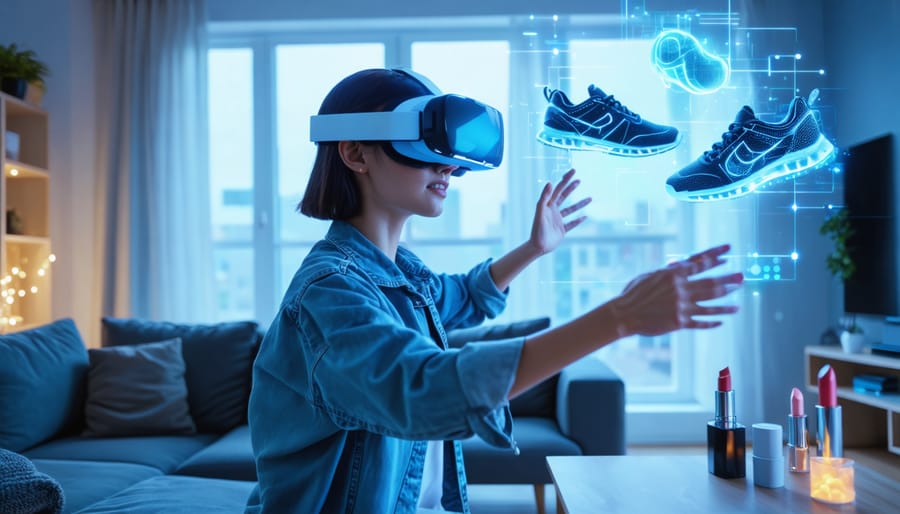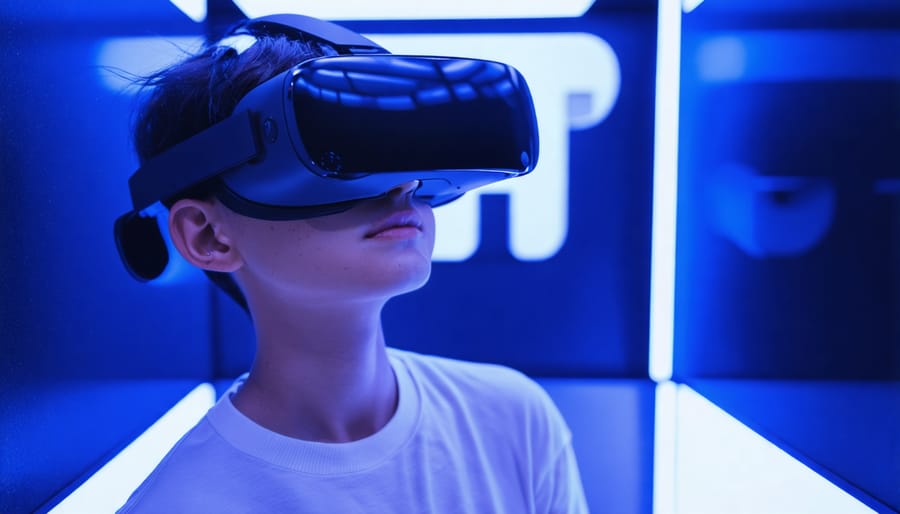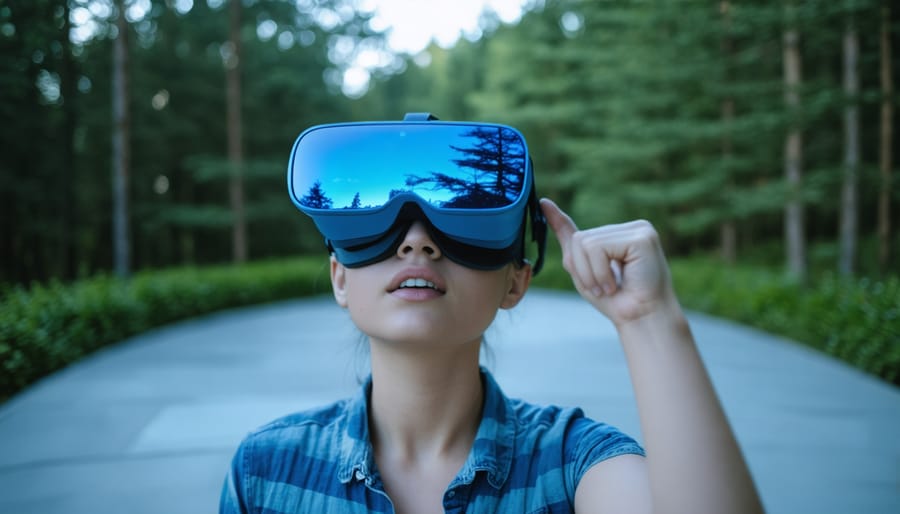Virtual Reality Ad Extensions Are Changing How Customers Shop (Here’s What You Need to Know)

**Leverage extended reality (XR) apps to transform your advertising campaigns from passive viewing experiences into immersive brand interactions.** XR technology—encompassing augmented reality (AR), virtual reality (VR), and mixed reality (MR)—now enables businesses to showcase products in customers’ actual environments, create memorable branded experiences, and drive measurable engagement through interactive ad extensions.
**Implement AR try-before-you-buy features** that let customers visualize furniture in their homes, test makeup shades on their faces, or preview product sizes before purchase. These experiences reduce return rates by 25-40% while increasing conversion rates significantly compared to traditional image-based ads.
**Deploy automated XR ad campaigns through existing platforms** like Google and Meta, which now support 3D asset uploads and AR ad formats without requiring custom app development. This approach eliminates the need for expensive in-house technical teams while maintaining professional quality standards.
**Focus on mobile-first XR experiences** since 85% of users access AR features through smartphones rather than dedicated headsets. Design lightweight, browser-based experiences that load quickly and function seamlessly across devices to maximize reach and minimize friction.
**Measure ROI through enhanced tracking capabilities** built into XR platforms, including engagement time, interaction depth, and conversion attribution. These metrics provide clearer performance insights than traditional display advertising, enabling rapid optimization and budget reallocation based on actual user behavior rather than estimated impressions.
What Extended Reality Apps Actually Mean for Your Ads

The Three Flavors of Extended Reality in Advertising
Extended reality encompasses three distinct technologies, each offering unique advantages for advertising campaigns. Understanding these AR vs VR differences helps you choose the right approach for your marketing goals.
**Virtual Reality (VR)** creates fully immersive digital environments that transport users completely away from their physical surroundings. In advertising, VR ad extensions allow customers to experience products in simulated settings—like test-driving a car through virtual landscapes or touring a property from their living room. This works particularly well for high-consideration purchases where customers need comprehensive product understanding before buying.
**Augmented Reality (AR)** overlays digital content onto the real world through smartphone cameras or AR glasses. IKEA’s furniture visualization app exemplifies this perfectly: customers see how a sofa looks in their actual living room before purchasing. AR ad extensions let shoppers virtually try on makeup, preview wall paint colors, or visualize appliances in their kitchens—all without leaving home.
**Mixed Reality (MR)** blends physical and digital elements that interact with each other in real-time. Unlike AR’s simple overlays, MR allows users to manipulate virtual objects as if they’re physically present. For advertisers, this means creating interactive product demonstrations where customers can rotate, customize, and examine 3D models that respond to physical movements and environmental factors.
Each technology serves different campaign objectives and budget levels, making it essential to match the right XR type with your specific advertising goals.
How Virtual Reality Ad Extensions Work Right Now
Platform Options That Support VR Extensions
Several major advertising platforms now support VR ad extensions, making it easier than ever to incorporate extended reality into your marketing campaigns. Google Ads has introduced immersive 3D ad formats that work seamlessly with VR-capable devices, allowing businesses to showcase products in virtual environments without extensive technical expertise. The platform’s automated setup process guides you through creation, requiring only standard product images to generate VR-compatible content.
Meta’s advertising ecosystem offers robust VR extension capabilities through its Quest platform and Instagram integration. Businesses can create immersive ad experiences that users view through VR headsets or mobile AR, with straightforward campaign management tools that mirror traditional ad setup processes.
Snapchat and TikTok have also entered the space with AR-enabled ad formats, though these lean more toward augmented reality than full VR experiences. These platforms excel in accessibility, as users don’t need specialized equipment beyond their smartphones.
Integration typically involves uploading 3D assets or using platform-provided templates. Most platforms offer self-service options with automated optimization, making VR extensions accessible even for small businesses without dedicated technical teams. The key is selecting platforms where your target audience already spends time.
The Customer Journey Through a VR Ad Extension
The customer journey through a VR ad extension follows a streamlined path designed to maximize engagement while minimizing friction. It begins when a potential customer encounters your standard display or social media ad featuring a “View in VR” or “Experience Now” call-to-action button.
Upon clicking, the system automatically detects their device capabilities. Mobile users receive a prompt to activate their smartphone’s gyroscope features, while desktop users can explore through click-and-drag navigation. No app downloads are required—the experience launches directly in their browser.
Within seconds, customers enter an immersive 3D environment where they can interact with your product. They might walk through a virtual showroom, examine a product from all angles, or experience your service in a simulated real-world setting. Interactive hotspots provide additional information, pricing details, and direct purchase options.
The entire journey typically lasts 30-90 seconds, striking the balance between meaningful engagement and maintaining attention. Throughout the experience, automated tracking captures valuable data on interaction points, time spent, and conversion triggers. This information feeds directly into your marketing automation systems, enabling immediate follow-up communication with prospects who demonstrated genuine interest.
Real Business Benefits Beyond the Hype

Engagement Metrics That Actually Matter
When evaluating VR ad extensions, focus on metrics that directly correlate with business outcomes rather than vanity numbers. tracking performance metrics becomes critical when justifying the investment in extended reality technology.
**Engagement duration** stands out as the most significant indicator. Traditional display ads capture attention for 2-3 seconds on average, while VR extensions consistently achieve 45-90 seconds of active interaction. This 15-30x increase in engagement time translates to better brand recall and message retention.
**Interaction depth** measures how users navigate through your VR experience. Track specific actions like product rotations, feature explorations, and virtual try-ons. Quality VR extensions see 60-75% of users engaging with at least three interactive elements, compared to 15-20% click-through rates on standard ads.
**Conversion lift** provides the clearest ROI picture. Companies implementing VR extensions report 20-35% higher conversion rates compared to campaigns using traditional formats alone. This improvement stems from increased confidence in purchase decisions after experiencing products virtually.
**Cost per engaged visitor** often surprises businesses positively. While initial impressions cost more, the extended engagement time means lower actual costs per minute of attention. Calculate this by dividing total campaign spend by minutes of active engagement rather than simple impressions.
Monitor these four metrics monthly to optimize your VR strategy and demonstrate tangible business value to stakeholders.
Where VR Extensions Deliver the Biggest Impact
Virtual reality extensions demonstrate measurable ROI across several key industries where visual presentation directly influences purchase decisions.
**Real estate** leads the pack, with agencies reporting up to 40% faster sales cycles when using VR property tours. Potential buyers can explore multiple properties remotely, filtering options before scheduling in-person visits. This automated screening process saves time for both agents and clients while expanding geographic reach.
**Furniture and home goods retailers** like IKEA and Wayfair have seen significant cart abandonment reductions—up to 35%—after implementing AR product visualization. Customers can place virtual furniture in their actual spaces, eliminating size and style uncertainty before purchasing.
**Automotive dealers** are closing deals with buyers who never visit showrooms. VR configurators let prospects customize vehicles, explore interiors, and experience test drives virtually. Dealerships report these tools qualify leads more effectively, allowing sales teams to focus on serious buyers.
**Fashion and retail** brands using virtual try-on technology report 25-30% higher conversion rates. The technology reduces return rates by helping customers make informed decisions about fit and appearance upfront.
**Travel and hospitality** companies leverage VR to showcase destinations and accommodations. Hotels offering virtual room tours see increased direct bookings, while tour operators use immersive experiences to differentiate premium packages from competitors.
The common thread? These industries all benefit from automated product visualization that maintains consistent quality while scaling customer communication efficiently.
Getting Started Without Breaking Your Budget

What You’ll Actually Need to Launch
You don’t need a million-dollar budget or a dedicated tech team to start with extended reality apps. Here’s what actually matters:
**Technical Requirements**
Start with a standard smartphone or tablet—most AR experiences run on devices your customers already own. For VR campaigns, consider partnering with platforms that provide viewer distribution rather than purchasing headsets upfront. Your existing website should be mobile-responsive, and you’ll need basic analytics integration for measuring campaign results.
**Content Essentials**
Begin with 3D models of your top three products or a simple 360-degree photo of your space. Professional 3D scanning services typically cost $500-$2,000 per item, but DIY smartphone apps can produce acceptable results for initial testing. Quality product photography from multiple angles works as a foundation—you don’t need Hollywood production values on day one.
**Platform Prerequisites**
Choose one platform initially. Google’s AR tools integrate directly with Search and Shopping ads, requiring minimal setup beyond a hosted 3D model file. Facebook’s Spark AR offers templates for quick deployment. Both platforms handle the heavy technical lifting through automated processes.
**Starting Simple**
Launch with a single product trial lasting 30 days. Monitor engagement metrics, gather customer feedback, and refine before expanding. Most businesses find success starting with their bestselling or highest-margin product rather than their entire catalog.
Building VR Content That Converts
Creating VR ad experiences that drive results requires a strategic approach focused on user engagement and clear outcomes. Start with product showcasing that leverages VR’s immersive capabilities—allow users to examine products from every angle, interact with features, and visualize items in realistic contexts. For example, furniture retailers can let customers place virtual pieces in their actual rooms, while automotive brands can offer detailed walkthroughs of vehicle interiors.
Environment design matters significantly. Keep virtual spaces intuitive and clutter-free to prevent user overwhelm. Use lighting, spatial audio, and visual cues to guide attention naturally toward key product features and brand messages. The environment should enhance your product, not compete with it.
Implementing calls-to-action in VR requires subtlety. Place interactive buttons or hotspots at natural pause points in the experience—after users have explored a product or reached a scenic viewpoint. Make CTAs visually distinct but contextually appropriate. Options like “Learn More,” “Schedule Demo,” or “Save to Wishlist” work well because they’re low-commitment and aligned with the exploratory nature of VR.
Track engagement metrics rigorously. Monitor which areas users spend time in, where they look, and which CTAs they activate. This data reveals what resonates and what needs refinement. Modern automated analytics platforms can process this information and provide actionable insights without requiring technical expertise, allowing you to optimize campaigns efficiently while maintaining clear communication with your marketing team about performance and ROI.
Automating VR Ad Management
Managing VR ad extensions manually becomes unsustainable as campaigns scale. Modern AI-powered ad tools automate bidding adjustments, audience targeting, and budget allocation based on real-time performance data. Set up automated rules to pause underperforming VR extensions and increase spend on high-converting experiences. Use dashboards that consolidate metrics across platforms, eliminating the need to check multiple systems daily. Schedule weekly performance reports to share with clients, highlighting engagement rates and cost-per-interaction automatically. This approach frees your team to focus on creative strategy while maintaining consistent campaign optimization.
Common Pitfalls and How to Avoid Them
Even the most promising XR advertising campaigns can fall flat when businesses make avoidable mistakes. Understanding these common pitfalls helps you launch effective campaigns from the start.
**Overcomplicating the Experience**
The biggest trap is creating experiences that are too complex or lengthy. Users expect quick, engaging interactions—not 10-minute tutorials. Keep your XR ad extensions simple and intuitive, with clear objectives achievable in under two minutes. Focus on one core message or product feature rather than cramming everything into a single experience. Test your prototype with users unfamiliar with your brand to ensure the experience is immediately understandable.
**Neglecting Mobile Users**
Many businesses develop stunning desktop VR experiences while forgetting that most users will access content on smartphones. Mobile devices account for over 60% of digital ad interactions, making mobile optimization non-negotiable. Design your XR experiences with mobile-first principles, ensuring they load quickly on cellular networks and work seamlessly on various screen sizes. Use WebXR standards that automatically adapt to different devices without requiring separate development tracks.
**Ignoring Loading Times**
Nothing kills engagement faster than extended loading screens. Large 3D assets and high-resolution textures can create frustrating delays that cause users to abandon your ad before experiencing it. Compress your assets appropriately, implement progressive loading that displays basic elements first, and use automated content delivery networks to serve files from geographically optimal locations. Aim for initial load times under three seconds.
**Misaligned Audience Targeting**
Rolling out XR campaigns to audiences without the necessary hardware or interest wastes budget quickly. Use platform analytics to identify users with compatible devices and demonstrated interest in interactive content. Start with controlled test campaigns targeting tech-forward demographics before expanding. Monitor engagement metrics closely during the first week and adjust targeting parameters based on actual interaction rates rather than assumptions about your audience’s capabilities.
Is This Right for Your Business?
Extended reality ad extensions aren’t a one-size-fits-all solution. Before committing resources, evaluate whether this technology aligns with your business objectives and audience expectations.
**Business size matters, but not how you’d think.** Small businesses with highly visual products—furniture retailers, home improvement services, or fashion brands—can benefit significantly from VR ad extensions. The technology levels the playing field, allowing smaller operations to deliver experiences previously reserved for major retailers. However, if your product is abstract or service-based without visual components, the investment may not deliver proportional returns.
**Your audience demographics play a crucial role.** VR ad extensions perform best with audiences aged 25-45 who are comfortable with technology and own compatible devices. If your customer base skews older or has limited smartphone access, traditional ad formats might serve you better initially. Run surveys or analyze your customer data before proceeding.
**Budget considerations require honest assessment.** While costs have decreased dramatically, expect to invest $2,000-$10,000 for professional 3D modeling and initial setup. Additionally, plan for ongoing maintenance and content updates. Calculate whether this investment aligns with your customer acquisition cost and lifetime value metrics.
**Product complexity is another deciding factor.** Items that benefit from visualization—like furniture placement, vehicle customization, or architectural services—see the highest engagement rates. Simple products with straightforward features may not justify the enhanced experience.
Start small with a pilot campaign targeting one product category. Track engagement metrics, conversion rates, and customer feedback over 60-90 days. This data-driven approach ensures you’re making informed decisions rather than following trends blindly. If results demonstrate clear ROI improvement over traditional ads, scale accordingly.
Virtual reality ad extensions represent a significant shift in how businesses can engage their audiences, and the technology is no longer reserved for enterprise-level companies with massive budgets. As platforms continue to simplify their tools and streamline integration processes, even small to medium-sized businesses can experiment with immersive advertising experiences.
The key to success lies in starting small and measuring what matters. Begin with a limited test campaign targeting a specific segment of your audience. Set clear performance metrics from the outset—whether that’s engagement time, click-through rates, or conversion data—and track them consistently. This approach minimizes risk while providing valuable insights into whether VR extensions align with your business objectives.
Effective implementation depends heavily on two critical factors: maintaining open communication with your clients or stakeholders about expectations and results, and leveraging automated processes wherever possible to reduce manual workload. Automation tools can handle bid adjustments, performance monitoring, and reporting, freeing your team to focus on creative strategy and optimization.
The businesses that will benefit most from VR ad extensions are those willing to test, learn, and adapt based on real data rather than assumptions.
Leave a Reply